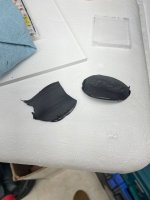If you do choose to use a solvent AP Airplane Plastics, who make the canopies, recommend Mineral Spirits to me to get bad tape glue residue off. From their website:
How should I clean my canopy?
Use cleaners specifically for acrylic. A damp cloth or an air blast will clean the dust away. To achieve the best results use fore and aft motion instead of a circular motion. To clean dirty acrylics use plenty of water and non-abrasive soap or detergent. All-cotton flannel can be used for drying. Never use aromatic solvents such as acetone, benzene, carbon tetrachloride, lighter fluid, lacquer thinners, gasoline, window sprays, concentrated alcohol, ketones or scouring compounds. Avoid using cleaners with ammonia, such as 409. Grease, oil or tape residue may be removed with kerosene, white gasoline, naphtha or isopropyl alcohol (Do not use isopropyl alcohol on extruded acrylic). Mineral spirits is our favorite. Wash approved solvents off of canopy with Dawn dishwashing liquid or equivalent and water followed by a clear water rinse. To prevent water spots, blow dry with compressed air or wipe dry with soft cotton flannel.





